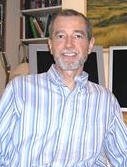
The Association for Computing Machinery (ACM) recently elevated Tom Dean to Fellow for his development of dynamic Bayes networks and anytime algorithms.
Tom is currently a staff research scientist at Google, Mountain View, and an Adjunct Professor of Computer Science here at Brown. He is known in AI for his work on the role of prediction in planning, control and decision-making where uncertainty and the limited time available for deliberation complicate the problem, particularly his work on temporal graphical models and their application in solving robotics and decision-support problems. His temporal Bayesian networks, later called dynamic Bayes networks, made it possible to factor very large state spaces and their corresponding transition probabilities into compact representations, using the tools and theory of graphical models. He was the first to apply factored Markov decision processes to robotics and, in particular, to the problem of simultaneous localization and map building (SLAM). Faced with the need to solve what were essentially intractable problems in real-time, Dean coined the name “anytime algorithm” to describe a class of approximate inference algorithms and the associated (meta) decision problem of deliberation scheduling to address the challenges of bounded-time decision making. These methods have been applied to large-scale problems at NASA, Honeywell and elsewhere.
At Google, Tom has worked on extracting stable spatiotemporal features from video and developed new, improved features for video understanding, categorization and ranking. From 1993 to 2007 he was Professor of Computer Science and Cognitive and Linguistic Sciences at Brown. He remains associated with the University through his Adjunct Professorship.
Tom received his B.A. in mathematics from Virginia Polytechnic Institute & State University in 1982 and his M.Sc. and Ph.D. in computer science from Yale University in 1984 and 1986 respectively. His research interests include automated planning and control, computational biology, machine learning, neural modeling, probabilistic inference, robotics and spatial and temporal reasoning.
Tom was named a fellow of AAAI in 1994. He served as the Deputy Provost of Brown University from 2003 to 2005, as the chair of Brown’s Computer Science Department from 1997 until 2002, and as the Acting Vice President for Computing and Information Services from 2001 until 2002. Tom was a founding member of the Academic Alliance of the National Center for Women and Information Technology and a former member of the IJCAI Inc. Board of Trustees. He has served on the Executive Council of AAAI and the Computing Research Association Board of Directors. Tom was also a recipient of an NSF Presidential Young Investigator Award in 1989. Dean is co-author with Mike Wellman of the Morgan-Kaufmann text entitled Planning and Control which ties together techniques from artificial intelligence, operations research, control theory, and the decision sciences. He is co-author with James Allen and John Aloimonos of Artificial Intelligence: Theory and Practice, an introductory text in Artificial Intelligence. His latest book, Talking With Computers is published by Cambridge University Press and examines a wide range of topics from digital logic and machine language to artificial intelligence and searching the web.
Commenting on what he is currently working on and excited about, Tom said, “More than a year ago I became concerned that the features that Google was using to catalog video were not good at capturing the fundamental characteristics of biological motion. When you look at the most popular videos on YouTube, they invariably involve biological motion, from sports and music videos to nature documentaries and misbehaving-pet videos. The effort of taking this initial observation and translating it into a set of algorithms for first learning motion features and then extracting them from video in better than real time has been both satisfying and humbling. The experience has also convinced me that a significant fraction of the image, video and audio data processing that we perform is better suited to a different model of computing than what we currently support in the cloud, hence my recent work on exploiting many-core computing in a way that is agnostic regarding both hardware and programming language. For most of the time I was at Brown, I was the only person working in robotics and decision making — regrettably, for much of the time that I overlapped with Chad, Michael and Leslie Kaelbling, I was up to my neck in administration. Now that I'm on the other side of the country, the department has hired two of the very best researchers working in the areas of computer vision that I'm most excited about. I'm referring to Erik's work on hierarchical graphical models and James' work on exploiting very large image corpora. I really appreciate the department providing me with even more incentives to visit.”
The ACM Fellows Program was established by Council in 1993 to recognize and honor outstanding ACM members for their achievements in computer science and information technology and for their significant contributions to the mission of the ACM. The ACM Fellows serve as distinguished colleagues to whom the ACM and its members look for guidance and leadership as the world of information technology evolves.
Tom joins the department’s seven other ACM Fellows: Maurice Herlihy, Franco Preparata, John Savage, Eli Upfal, Andy van Dam, Peter Wegner and Stan Zdonik.
